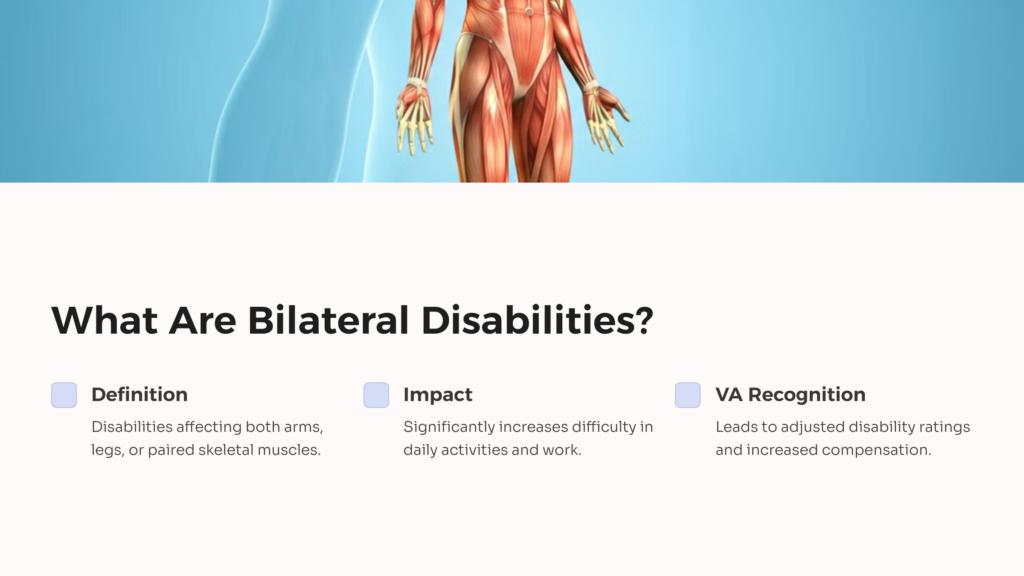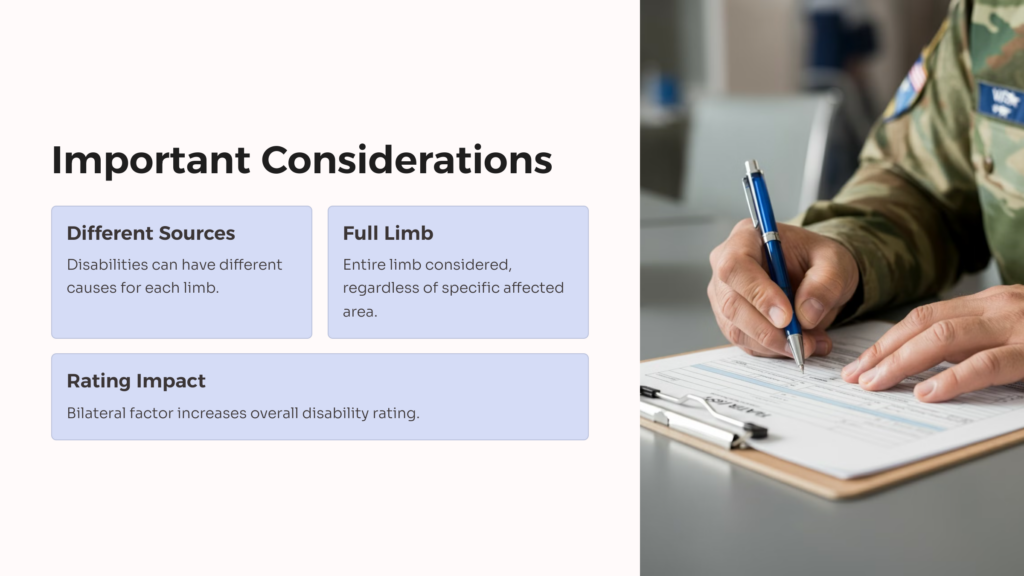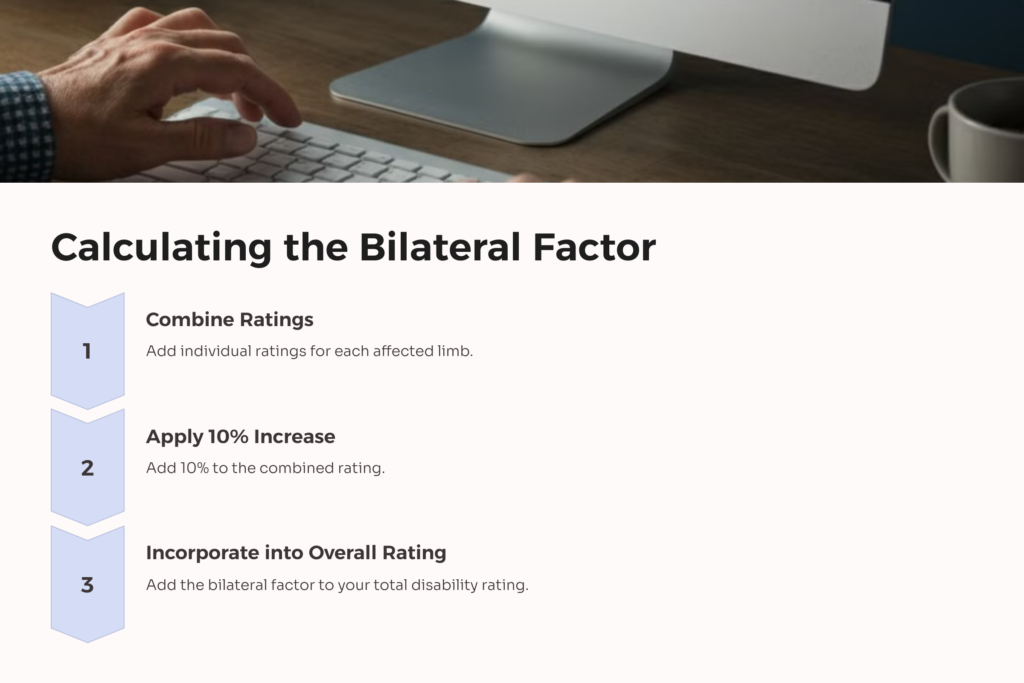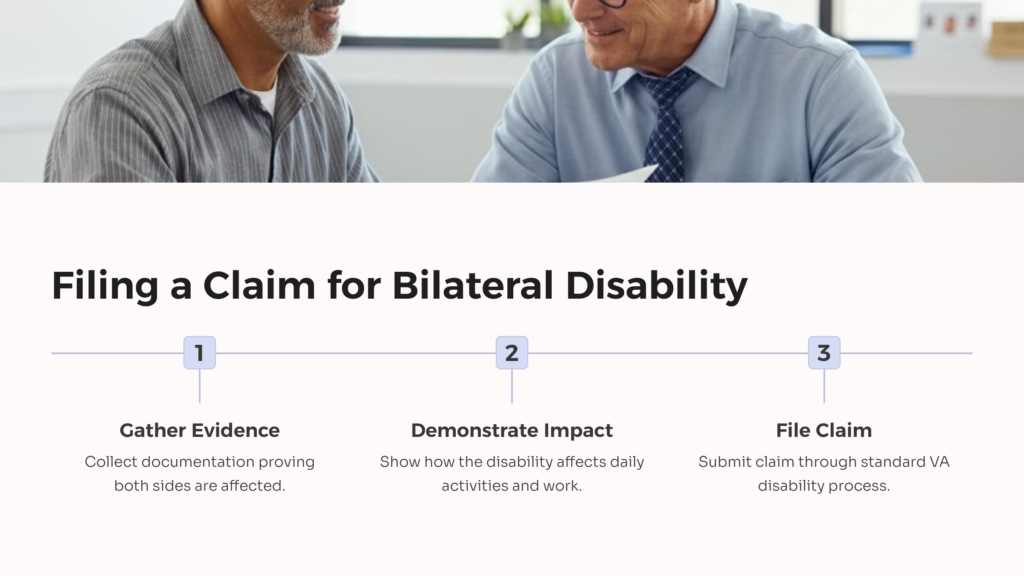Service-connected conditions come in all different shapes and sizes. And even with similar diagnoses, the difficulties and experiences can (and usually do) vary between veterans. One thing that just about everyone—including the VA—agrees on is this:
Working with one hand tied behind your back is hard. Working with both tied behind your back is much worse.
When veterans struggle with the complete loss of use of a limb in some way or instead see a reduction in their ability to use it, the severity of hardships that result is force multiplied when it’s mirrored in the opposite limb.
The VA refers to this kind of two-pronged disability as “bilateral disability,” and it can have an appreciable impact on the disability benefits veterans receive.
So let’s talk about what counts as a bilateral disability, how it affects your disability rating, and what it takes to secure the full amount of benefits you qualify for.

Bilateral Disabilities: This Tango Takes Two
Let’s assume you’ve already been briefed on VA disability basics (check here for a quick sit-rep if you need it) [link to other articles]. Bilateral disabilities, or any disability that qualifies for the “bilateral factor,” are treated in much the same way. VA disability benefits are measured and weighted based on the impact your disability (or disabilities) has on your ability to move, work, and live. This then affects the disability rating you are assigned, directly corresponding to the compensation you receive.
The main difference here is that a disability is “bilateral” whenever there are issues that affect both sides—both arms, both legs, or both of a set of paired skeletal muscles. For situations that fall under this definition, the disability rating veterans receive is adjusted to reflect the increased difficulty they experience.
What Qualifies for the Bilateral Factor?
Bilateral disabilities, like any VA disability and condition, are defined very narrowly. The bilateral factor only applies if one of the following is true:
- Both arms are affected
- Both legs are affected
- Both muscles in a skeletal pair are affected.
Strictly speaking, it’s not a matter of port plus starboard; an arm and a leg don’t count as bilateral, even if they’re on opposite sides of the body, for example. According to the VA, bilateral (which, to be fair, does literally mean “both sides”) only refers to disabilities that affect both parts of a pair (e.g. both arms, or both legs, but not one arm and one leg).
This pair-based definition is the most important aspect of qualifying for increased disability benefits from the bilateral factor. If this very specific condition isn’t met, then none of the other details are relevant. In fact, other details are largely irrelevant either way.

For the purposes of determining whether you qualify for bilateral disability benefits, the VA doesn’t distinguish between parts of the limb. That means that “arm” refers to anything from the shoulder joint to the fingertips, and “leg” similarly refers to anything from the hip joint to the soles of the feet. That’s even true even if veterans experience the symptoms in different parts of either limb (e.g. the knee on the left, the foot on the right).
Beyond that, a pair of limbs still qualify even if the source of the disability in each limb is different. The only requirement for veterans is that both are affected. The reasoning here is pretty straightforward: there are a lot of activities that become much harder if both your right arm and your left arm are difficult or painful to use. And it’s much harder to stand, walk, or run if you don’t have at least one leg that’s still at 100%.
How Do Bilateral Factor Calculations Impact My Disability Rating?
Determining your disability rating can be complicated normally, and throwing in a bilateral disability can make it more so. But let’s see what we can do to break it down.

Typically, a disability rating is assigned in increments of 10%. Determining a composite rating changes this once you start compiling each individual disability rating together to calculate your combined rating, but the bilateral factor goes a step further. You take each rating from each disabled limb in the pair, combine them, and then add 10% on top of that, before adding it all to your combined rating.
Here’s what it looks like. If a veteran’s disability rating in their right arm is, say, 20%, and their disability rating in their left arm is around 30%, then the bilateral factor would add these two figures, giving you 50%. Then, their rating is increased by ten percent, leaving you with 55%. Only after all of that is the figure added to the calculations for their overall disability rating.
If that sounds a bit convoluted to you, then you’ll be happy to know that there’s also a very handy VA bilateral disability calculator [CTA link?], in addition to the more general VA disability rating calculator, available to veterans to help simplify and streamline the work of estimating how the bilateral factor will affect your disability rating.
“Ok, So How Do I Get the VA to Acknowledge a Bilateral Disability?”
This is a fair question. The good news is, the process is very similar to a standard VA disability claim. When filing any VA disability claim, veterans always need to provide evidence and supporting documentation.
In addition to demonstrating how conditions are service-connected, and how they’ve impacted your life in adverse ways, veterans also need to provide evidence to support the following:
- Each side of the pair in question is affected by a service-connected disability in some way.
- The disability has impacted your ability to accomplish normal activities that require the full pair.
- Your ability to perform work, engage in common activities, and otherwise live your life, has been negatively impacted by the compounded impairment of the disabled limbs.
Other than that, the process is largely identical to standard VA disability claims.
“Should I File a Claim for a Bilateral Disability?”

It’s understandable to cringe at the idea of filing additional paperwork with the VA. To paraphrase a classic film from the previous millennium, “Anyone who says they like red tape is either lying or selling something.” But your disability compensation rates may increase enough to make it worthwhile to file a new claim or revisit an existing one if you think you qualify for the bilateral factor.
First, if the VA determines that the bilateral factor applies to your disability rating, your rating will go up, which means your benefits and compensation rates will go up too. How much it will go up depends on the specifics of your conditions and current disability rating. Again, a VA bilateral disability calculator [CTA plug redux?] can help you determine whether the increase is worth the effort of going through the claims process for this.
Second, the bilateral factor can help you qualify for total disability individual unemployment (TDIU).
Qualifying for TDIU requires either a single disability rated at 60% or more or a combined rating of at least 70% (with a single disability rated at 40% or more). In the case of the latter, a bilateral disability can help you meet the 70% minimum for your combined disability rating.
In the end, you are the best judge of your own experiences, needs, and circumstances. You’re the boots on the ground, so to speak. But sometimes making the right call depends on having all of the available intel, and when that’s the case, AllVeteran is here to help.
 AllVeteran.com Advisors
AllVeteran.com Advisors
With expertise spanning local, state, and federal benefit programs, our team is dedicated to guiding individuals towards the perfect program tailored to their unique circumstances.











